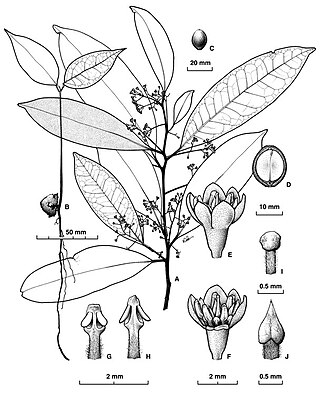
Cryptocarya is a genus of about 360 species of flowering plants in the laurel family, Lauraceae. Most species are trees, occasionally shrubs, distributed through the Neotropical, Afrotropical, Indomalayan, and Australasian realms. Most plants in the genus Cryptocarya have leaves arranged alternately along the stems, small flowers with 6 tepals, stamens in 2 rows, the inner row alternating with staminodes, and the fruit is a drupe.

Geijera salicifolia, commonly known as glasswood, green satinheart or scrub wilga, is a species of shrub or tree in the family Rutaceae and is native to Australia, New Guinea and New Caledonia. It has narrow elliptic to egg-shaped leaves, small white flowers in loose groups and oval to more or less spherical fruit, each containing a shiny black seed.

Cryptocarya glaucescens, commonly known as jackwood, is a rainforest tree of the laurel family growing in eastern Australia.

Elaeocarpus obovatus, commonly known as hard quandong, blueberry ash, whitewood, grey carabeen, freckled oliveberry or gray carrobeen, is a species of flowering plant in the family Elaeocarpaceae and is endemic to eastern Australia. It is a tree with buttress roots at the base of the trunk, egg-shaped to lance-shaped leaves with the narrower end towards the base, racemes of white flowers, and blue, oval fruit.

Cryptocarya bidwillii, commonly known as yellow laurel, is a species of flowering plant in the laurel family and is endemic to eastern Australia. Its leaves are lance-shaped to elliptic, the flowers creamy-white and tube-shaped, and the fruit an elliptic black drupe.

Halfordia is a genus of plants in the family Rutaceae containing the single species Halfordia kendack commonly known as kerosenewood, southern ghittoe or saffronheart, is a rainforest plant that is native to eastern Australia, New Guinea and New Caledonia. It is a shrub or tree with elliptical to egg-shaped leaves with the narrower end towards the base, panicles of white, greenish white or yellowish flowers and purple to bluish black, spherical to oval fruit.

Acronychia acronychioides, commonly known as white aspen, is a species of small to medium-sized rainforest tree that is endemic to north-eastern Queensland. It has trifoliate leaves with elliptic to egg-shaped leaflets on stems that are more or less cylindrical, creamy yellow flowers in large groups in leaf axils and fleshy, pear-shaped or spherical fruit.

Acronychia crassipetala, commonly known as crater aspen, is a species of small rainforest tree that is endemic to north-eastern Queensland. It has simple, elliptic to egg-shaped leaves on cylindrical stems, flowers in small groups, and fleshy, more or less spherical fruit.
Acronychia eungellensis, commonly known as Eungella aspen, is a species of small rainforest tree that is endemic to a restricted area in east-central Queensland. It has simple, elliptic leaves on cylindrical stems, flowers in small groups in leaf axils, and fleshy fruit that is elliptic to egg-shaped in outline.

Acronychia parviflora is a species of shrub or small rainforest tree that is endemic to north-eastern Queensland. It has simple, egg-shaped to elliptical leaves, flowers arranged singly or in small groups in leaf axils and fleshy, more or less spherical fruit.

Acronychia vestita, commonly known as white aspen, lemon aspen, hairy aspen or fuzzy lemon aspen, is a species of rainforest tree that is endemic to Queensland. It has simple, elliptic to egg-shaped leaves with the narrower end towards the base, flowers arranged in relatively large groups, mostly in leaf axils and fleshy, pear-shaped to more or less spherical fruit.

Elaeocarpus culminicola, commonly known as Michael's quandong, is a species of flowering plant in the family Elaeocarpaceae and is native to parts of Malesia and Australasia. It is a tree with wavy leaves with wavy or toothed edges, racemes of white, cream-coloured or pink flowers and more or less spherical fruit.
Elaeocarpus stellaris is a species of flowering plant in the family Elaeocarpaceae and is endemic to north-eastern Queensland. It is a tree, sometimes with buttress roots at the base of the trunk, elliptic to egg-shaped leaves, small groups of flowers with greenish-yellow sepals and creamy-white petals, the fruit containing a five-flanged stone.

Cryptocarya angulata, commonly known as ivory laurel, ivory walnut, bull's breath or acidwood, is a tree in the laurel family and is endemic to north Queensland, Australia. Its leaves are lance-shaped to elliptic or egg-shaped, the flowers tube-shaped and creamy-green and the fruit a bluish or black drupe.

Cryptocarya bamagana, commonly known as Bamaga walnut, is a tree in the laurel family and is endemic to Cape York Peninsula. Its leaves are lance-shaped to elliptic or egg-shaped, the flowers cream-coloured and tube-shaped, and the fruit a spherical black drupe.

Cryptocarya bellendenkerana is a tree in the laurel family and is endemic to North Queensland. Its leaves are lance-shaped to egg-shaped, the flowers creamy-green and tube-shaped, and the fruit a spherical black drupe.

Cryptocarya brassii is a species of flowering plant in the laurel family and is native to far north Queensland and Papua New Guinea. Its leaves are elliptic to oblong or lance-shaped, the flowers cream-coloured and tube-shaped, and the fruit an elliptic black to bluish-black drupe.

Cryptocarya burckiana is a tree in the laurel family and is native to Cape York Peninsula in Queensland and to Malesia. Its leaves are lance-shaped to elliptic, the flowers cream-coloured and tube-shaped, and the fruit a spherical black drupe.
Cryptocarya cercophylla is a species of flowering plant in the laurel family and is endemism to Wooroonooran National Park in north Queensland. It is a poorly-formed tree with egg-shaped to elliptic leaves, the flowers creamy-green or cream-coloured and tube-shaped, and the fruit an elliptic, red to shiny black drupe.

Cryptocarya claudiana, commonly known as Claudie laurel, is a tree in the laurel family and is endemic to Cape York Peninsula in Queensland. Its leaves are oblong to elliptic, the flowers creamy-green, perfumed and tube-shaped, and the fruit an elliptic or spherical black drupe.

















